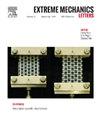Tiny scale defect contour recognition on curved structure based on electromagnetic thermography
IF 4.5
3区 工程技术
Q2 MATERIALS SCIENCE, MULTIDISCIPLINARY
引用次数: 0
Abstract
Precision spherical pressure vessels are used in critical pressure-bearing structures due to their excellent structural strength. The surface of the spherical shell may experience corrosion in long-term service, leading to the formation of tiny pitting defects, which cause a risk to the structural integrity. A high-precision, non-destructive method is required for tiny defects detecting and contour recognition. In this paper, firstly, a new sensor consisting of a rotatable yoke and spherical adaptive flexible material with high permeability (FMHP) is designed to improve the performance of the electromagnetic thermography, which achieves the detection of tiny scale defects in spherical shell surface with diameter of 40μm. Secondly, super-resolution algorithms based on machine learning and deep learning are developed to realize the contour recognition of tiny defects, indicating that the generative adversarial network has an optimum performance. Then, to address the distortion phenomenon in infrared imaging of spherical structures, a coordinate transformation-based image correction algorithm is developed, enabling the accurate reconstruction of defect contours.
基于电磁热成像的曲面结构微小缺陷轮廓识别
精密球形压力容器以其优异的结构强度被广泛应用于关键的承压结构中。球壳表面在长期使用中可能受到腐蚀,形成微小的点蚀缺陷,对结构完整性造成威胁。微小缺陷检测和轮廓识别需要高精度、非破坏性的方法。为了提高电磁热像仪的性能,本文首先设计了一种由可旋转磁轭和高磁导率球形自适应柔性材料(FMHP)组成的新型传感器,实现了对直径为40μm的球形壳体表面微小缺陷的检测。其次,开发了基于机器学习和深度学习的超分辨算法,实现了微小缺陷的轮廓识别,表明生成式对抗网络具有最佳性能。然后,针对球面结构红外成像中的畸变现象,提出了一种基于坐标变换的图像校正算法,实现了缺陷轮廓的精确重建。
本文章由计算机程序翻译,如有差异,请以英文原文为准。
求助全文
约1分钟内获得全文
求助全文
来源期刊

Extreme Mechanics Letters
Engineering-Mechanics of Materials
CiteScore
9.20
自引率
4.30%
发文量
179
审稿时长
45 days
期刊介绍:
Extreme Mechanics Letters (EML) enables rapid communication of research that highlights the role of mechanics in multi-disciplinary areas across materials science, physics, chemistry, biology, medicine and engineering. Emphasis is on the impact, depth and originality of new concepts, methods and observations at the forefront of applied sciences.
 求助内容:
求助内容: 应助结果提醒方式:
应助结果提醒方式:


